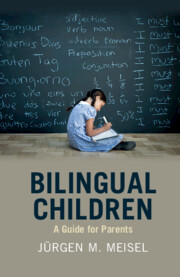Book contents
- Bilingual Children
- Bilingual Children
- Copyright page
- Dedication
- Contents
- Preface
- Abbreviations
- 1 Bilingualism in Early Childhood
- 2 How Infants Become Native Speakers
- 3 Two Languages in One Mind
- 4 Keeping Languages Apart
- 5 Language Dominance
- 6 Trilingual and More
- 7 The Age Question
- 8 Benefits and Advantages of Child Bilingualism
- Bibliography
- Index
- References
4 - Keeping Languages Apart
Mixing, Interference and Interaction of Languages
Published online by Cambridge University Press: 08 June 2019
- Bilingual Children
- Bilingual Children
- Copyright page
- Dedication
- Contents
- Preface
- Abbreviations
- 1 Bilingualism in Early Childhood
- 2 How Infants Become Native Speakers
- 3 Two Languages in One Mind
- 4 Keeping Languages Apart
- 5 Language Dominance
- 6 Trilingual and More
- 7 The Age Question
- 8 Benefits and Advantages of Child Bilingualism
- Bibliography
- Index
- References
Summary
Now that we know that simultaneous bilinguals can differentiate languages from early on, the question is whether they can keep them apart during later developmental phases. After all, we know that all languages of multilinguals are constantly activated, though at different levels. Research has shown that activation does not normally trigger interference resulting in non-native competences. Bilinguals are able to keep systems apart, even when switching between them in language use. When code-switching happens within utterances, it is constrained by grammatical properties of both languages involved. Switching is also constrained by contextual and social factors. Bilingual children have to acquire the required knowledge, grammatical as well as pragmatic, in order to be able to code-switch like adults. In cases where cross-linguistic interaction happens, it never affects all parts of, only some aspects. Moreover, it is typically a temporary effect that does not indicate a failure to separate languages. Rather, it is a performance phenomenon. Children exposed to mixed speech tend to mix more frequently themselves. They are nevertheless able to develop separate grammars that show no signs of interference.
Keywords
- Type
- Chapter
- Information
- Bilingual ChildrenA Parents' Guide, pp. 93 - 122Publisher: Cambridge University PressPrint publication year: 2019



